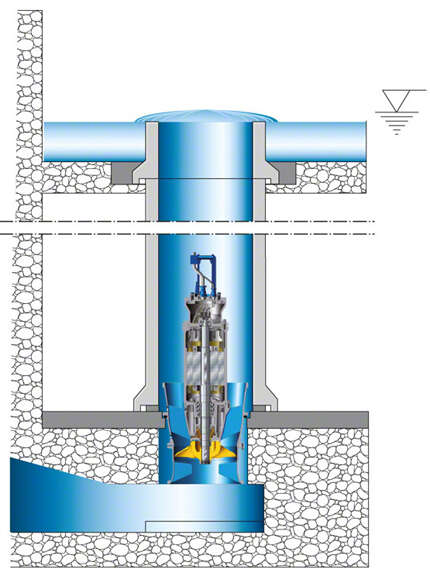Submersible pump in discharge tube
A submersible pump in discharge tube consists of a centrifugal pump and a submersible motor. The fluid handled flows through the impeller in axial direction. The pump is suspended directly in the discharge tube. See Fig. 1 Submersible pump in discharge tube

Fig. 1 Submersible pump in discharge tube: Submersible motor pump in concrete discharge tube
These pumps are usually installed vertically; in special cases they can also be installed in an inclined or horizontal position.
Submersible pumps in discharge tubes are not self-priming, which means that the propeller (as an axial impeller) always has to be sufficiently covered by the fluid handled. This is why wet well installation is typically chosen. The top of the intake chamber can be open or covered.
Depending on the specific speed, the impeller is designed as an axial flow impeller, mixed flow impeller or channel impeller. When the pump is installed, its diffuser ends directly in the discharge tube, which can be designed with an elbow for above floor or underfloor discharge, or as an overflow version.
Regardless of the type of installation and the discharge tube design, the surface-cooled dry-rotor submersible motors (see submersible motor pump) of submersible pumps in discharge tubes are permanently cooled by the fluid flowing along the motor during operation.
Submersible pumps in discharge tubes are suitable for applications which cannot be covered by conventiona tubular casing pumps or vertical shaft submersible pumps.
One of their benefits is that structural work is kept to a minimum. Submersible pumps in discharge tubes are usually installed underfloor with the submersible motor pump suspended in a discharge tube made of concrete, sheet steel, or increasingly also of GFRP (Glass Fibre Reinforced Plastics).
The actual outlet line is arranged underneath the floor on which the discharge tube is placed. A building above this arrangement is not required.
Mobile lifting equipment is used for installation and removal.
The benefits of this simple building design, easy installation, maintenance and repair increase with the depth of the discharge tube and the installation depth of the pump. Submersible pumps in discharge tubes can easily be pulled out as a single unit. This sets them apart from conventional tubular casing pumps or deep-well turbine pumps, which require a complex and time-consuming disassembly of drives, shaft assemblies and discharge pipe.
Installation variants for a discharge tube with open overflow, for example, can only be realised with submersible pumps in discharge tube design. Axial flow impellers (e.g. propellers) reach heads of up to 12 m, mixed flow propellers up to 55 m and channel impellers up to 30 m.
Hydraulic systems with axial flow or mixed flow impellers can pump very high flow rates of 10 to 20 m³/s. The performance range of propeller pumps is decisive for matching them to their applications.
Main applications of propeller pumps
- Irrigation and drainage pumping stations
- Waste water treatment plants and stormwater stand-by tanks
- Raw and clean water pumps in water works
- Cooling water pumps in power stations and industry
- Industrial water supply
- Flood, disaster and water pollution control
- Pumps for docks and locks
- Fish farms/aquaculture
- Leisure park water attractions
- Transporting and recirculating fluids in environmental and plant engineering projects
